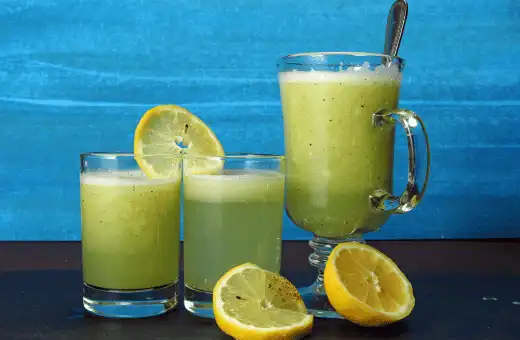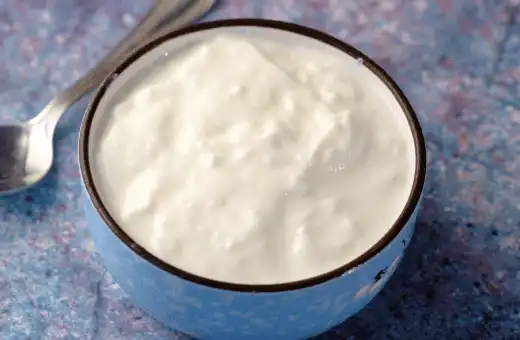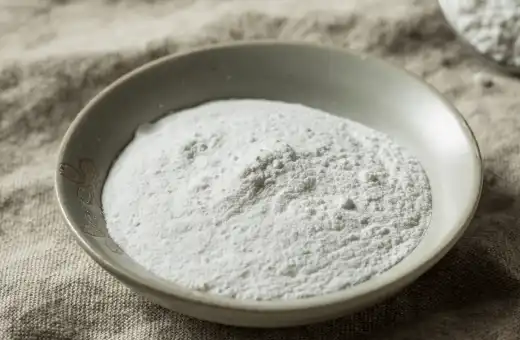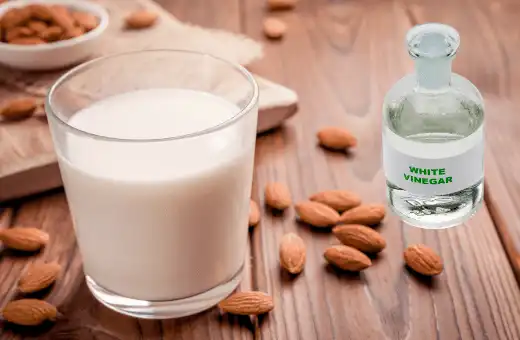Buttermilk is a common ingredient in many recipes, particularly in baking, as it adds a tangy flavor, helps with leavening, and creates a moist texture in baked goods.
However, it’s not always readily available in every kitchen. Moreover, some people may have dietary restrictions that prevent them from consuming buttermilk.
But luckily, there are many alternatives to buttermilk that you can use in your recipes. In this post, I’ll share 17 of the best buttermilk substitutes, their ratios, and how to use them.
In short, " What can I use instead of buttermilk?" Milk and Lemon Juice, Milk and Vinegar, Yogurt, Sour Cream, Cream of Tartar, Kefir, Almond Milk and Vinegar, Milk and Yogurt, Milk and Cream of Tartar, Buttermilk Powder, Sour Milk, Coconut Milk with Lemon Juice and many more.
What is buttermilk, and what does buttermilk taste like?
Buttermilk is a type of cultured or fermented milk that is made by adding lactic acid-producing bacteria to regular milk.
This process gives the buttermilk a slightly sour, acidic flavor and thick texture.
It also has a creamy and slightly tangy taste with mild notes of sweetness that come from the stabilized lactic acid bacteria in it.
The texture of buttermilk can range from thin to thick depending on whether it’s traditional or cultured/cultivated varieties, respectively.
Additionally, while some buttermilks have subtle flavors, others can be quite strong when used as ingredients in cooking due to fermentation processes and additional flavoring agents added during their production.
Uses of buttermilk
Buttermilk is a popular ingredient used in many dishes, both sweet and savory. It adds a creamy texture and tangy flavor to recipes like pancakes, biscuits, dressings, marinades, and dips.
Buttermilk can also be used as a substitute for other dairy ingredients, such as regular milk or yogurt.
The bacteria in buttermilk also produce beneficial compounds that act as antioxidants to help preserve food, so buttermilk is often added to baked goods to extend their shelf life.
In addition to being a great baking ingredient, buttermilk can also be used for tenderizing meats and fish, such as chicken tenders or fried catfish.
The acid in the buttermilk reacts with proteins in the meat, creating softer textures with more flavor.
Using buttermilk instead of water when soaking tougher cuts of meat helps break down some of their fibrous tissue, making them more tender after cooking.
Buttermilk can also be used to make refreshing beverages like smoothies, protein shakes, or even cocktails!
Its creamy texture and mild tartness make it an ideal base for mixing up summertime drinks that are both tasty and healthy.
Where to buy buttermilk?
If you are looking for where to buy buttermilk, there are a few different places you can go. Many specialty food stores carry it, as do some international grocery stores.
You can also order online from many retailers that provide a variety of diverse flavors and types of buttermilk.
best buttermilk substitutes
1. Milk and Lemon Juice – a good buttermilk substitute

This is the most common alternative to buttermilk.
Ratio or measurement: To make this substitute, you'll require 1 tablespoon of lemon juice and 1 cup of milk.
Blend the lemon juice into the milk and let it sit for five minutes.
The lemon juice acid will curdle the milk, giving it a similar texture and tang as buttermilk.
2. Milk and Vinegar
Ratio or measurement: Similar to the milk and lemon juice method, this substitute uses one tablespoon of vinegar and one cup of milk.
Again, let it sit for five minutes, and you’ll have a tangy, buttermilk-like substance.
3. Try Yogurt to replace buttermilk

Plain, unflavored yogurt is another great buttermilk substitute.
Ratio or measurement: You can use it in equal parts for the recipe, making sure to whisk it well to remove any lumps.
4. Sour Cream
Sour cream can use in place of buttermilk, but it’s a bit thicker.
Ratio or measurement: To create a similar texture, add a little bit of milk to your sour cream and mix well.
5. Cream of Tartar – a great buttermilk alternative

This method requires a bit of chemistry.
Ratio or measurement: To replace one cup of buttermilk, add one and a half tsp of cream of tartar mix with 1 cup of milk.
Mix well and let it sit for five minutes. This substitute won’t have the tanginess of buttermilk, but it will provide the acidity needed for leavening.
6. Kefir
Kefir is a fermented milk drink is a tangy, yogurt-like flavor.
Ratio or measurement: You can substitute it in equal amounts for buttermilk, and it'll add a unique flavor to your recipe.
7. You can use Almond Milk and Vinegar instead of buttermilk

If you’re looking for a non-dairy alternative to buttermilk, then try this combo.
Ratio or measurement: Mix one cup of almond milk with one tablespoon of vinegar.
Let it sit for five minutes, and you’ll have a tangy, dairy-free substitute.
8. Milk and Yogurt
Another popular alternative to buttermilk is milk and yogurt.
Ratio or measurement: For this substitution, mix one tablespoon of plain yogurt into one cup of milk.
The resulting mixture will have a slightly tangy flavor that works well in baked goods.
Just like the milk and vinegar combination, let the mixture sit for a few minutes before using it in your recipe.
9. Milk and Cream of Tartar – a decent buttermilk replacement
If you’re out of buttermilk and vinegar or lemon juice, you can utilize cream of tartar instead.
Ratio or measurement: Combine 1 and a half teaspoons of cream of tartar with 1 cup of milk, and let it sit for five to ten minutes.
This will give your recipe the acidity and tanginess of buttermilk.
10. Buttermilk Powder
Buttermilk powder is a shelf-stable alternative to liquid buttermilk.
It’s not a common pantry staple, but it’s worth keeping some on hand if you often make pancakes, biscuits, or cakes.
Ratio or measurement: Mix the powder with water according to the package's instructions, and use the resulting mixture in your recipe.
11. Sour Milk – similar taste to buttermilk

Ratio or measurement: To make sour milk, add lemon juice to 1 cup or 1 tablespoon of vinegar of regular cow's milk and let stand for five minutes before using.
This combination yields a concoction that is very similar to buttermilk and can also be used as a direct replacement in recipes.
12. Coconut Milk with Lemon Juice
Coconut milk, on its own, tastes sweet and creamy.
However, when combined with one tablespoon of lemon juice per cup of coconut milk, it will have a tangy taste that mimics the flavor of traditional buttermilk quite well.
Ratio or measurement: This substitution should also work at a 1:1 proportion in most recipes.
13. Soy Milk with Vinegar or Lemon Juice is an ideal buttermilk substitute
Ratio or measurement: Much like almond milk, soy milk works well as an alternative to regular cow's milk when paired up with either vinegar or lemon juice at the same ratio of one tablespoon per cup of soy milk for optimal acidic flavor.
The results mimic those found in traditional buttermilk recipes nicely without having any animal products involved whatsoever.
Making it great for those who adhere to vegan/vegetarian lifestyles as well as those who have allergies to dairy products, such as lactose intolerance sufferers too!
14. Cashew Milk With Vinegar Or Lemon Juice
Cashew Milk is another popular nut-based beverage option that contains no added sugar, which makes it another great choice for vegans looking for an adequate substitution for buttery goodness in their baking recipes!
Ratio or measurement: Simply add one tablespoon of vinegar or lemon juice per cup of cashew milk for optimal acidity and tanginess akin to what you would expect from real buttermilk!
15. Rice Milk With Vinegar Or Lemon Juice – similar taste to buttermilk
Ratio or measurement: Use a ratio of 1 TBSP per 1 Cup, and this mixture yields results much like what you would expect from fresh buttermilk without all the animal product content.
Rice Milk is yet another popular dairy-free alternative that works great when paired with either vinegar or lemon juice.
Making it ideal if you are looking for both plant-based options as well as those who may suffer from allergies related to traditional dairy products!
16. Hemp Milk With Vinegar Or Lemon Juice
Hemp Milk offers lots more nutrition than some other non-dairy beverages due to its high Vitamin A & D content which also helps enhance the overall flavor.
When mixed together with either vinegar or lemon juice at the same ratio mentioned earlier (1 TBSP per Cup), create results very similar in flavor and consistency compared to real buttermilk!
17. Potato Starch Water – gives you a similar taste to buttermilk
Last on our list is Potato Starch Water, which does not contain actual starch or potatoes (so don’t worry about your baked goods coming out spud-filled!).
Potato Starch Water can be created by adding 2 tablespoons of potato starch into 2 cups of cold water and then mixing until dissolved.
This liquid creates plenty of tanginess needed without any dairy content, making it perfect for vegans/vegetarians looking for viable options!
Ratio or measurement: Of course, this should be used as a 1:1 ratio in place of real buttermilk, and you're good to go!
Tips on How to Choose the Most Suitable Substitution Option for Buttermilk
When choosing a suitable substitution for buttermilk, consider the following tips:
1. Acidic Dairy Substitutes: Buttermilk is acidic, so look for substitutes with a similar acidity level. Options include yogurt, sour cream, or kefir.
These can be thinned with a bit of water or milk to match the consistency of buttermilk.
2. Plant-Based Alternatives: If you prefer non-dairy options, consider using plant-based alternatives like almond milk, soy milk, or oat milk.
Count 1 tbsp of vinegar or lemon juice per cup of milk to create a slightly acidic substitute.
3. Mixing Vinegar/Lemon Juice with Milk: You can make a homemade buttermilk substitute by blending 1 cup of milk with 1 tbs of vinegar or lemon juice.
Let it sit for 5-10 minutes to allow the acid to curdle the milk slightly.
4. Flavor Considerations: Keep in mind that each substitution option may have a slightly different taste profile.
Consider the flavor impact on your recipe and choose a substitute that complements the other ingredients.
5. Recipe Specifics: Some recipes may require the unique texture and tang of buttermilk, especially in baked goods.
In such cases, it is best to use a substitute that closely mimics the properties of buttermilk, such as yogurt or sour cream.
the best substitute for buttermilk in the cake
Buttermilk plays a crucial role in making cakes moist and fluffy. Fortunately, there are several substitutes for buttermilk that can be used to achieve similar results.
Yogurt is a popular substitute for buttermilk in baking recipes.
To use yogurt as a substitute for buttermilk, mix one cup of yogurt with 1 tablespoon of white vinegar or lemon juice.
This mixture can be used in place of 1 cup of buttermilk needed in the recipe.
Additionally, sour cream can also be used instead of buttermilk. For each cup of buttermilk needed in the recipe, use ¾ cup of sour cream plus ¼ cup water.
Another option is to combine one and a half cups of whole milk with one and a half tablespoons of white vinegar or lemon juice.
This combination should be allowed to sit for about 10 minutes before being added to the cake batter mix.
Finally, if you have almond or coconut milk on hand, you can make your own vegan-friendly version of buttermilk by stirring together 1 cup of almond or coconut milk and 1 tbs of white vinegar or lemon juice.
the best substitute for buttermilk in fried chicken
Buttermilk is often used in fried chicken recipes due to its tangy flavor and creamy texture. However, if you don’t have any on hand, there are other options that can still give you a delicious result.
Plain Greek yogurt can be substituted in a 1:1 ratio for buttermilk. The acidity of the yogurt will tenderize the chicken just like buttermilk would.
Alternatively, you can combine milk, lemon juice, or white vinegar to create a flavorful substitution.
Simply combine one cup of milk with 1 tbsp of lemon juice or vinegar and let it sit for 10 minutes.
This mixture should be mixed into the recipe as you would use buttermilk for an equally tasty result.
the best substitute for buttermilk in pancake
If you don’t have buttermilk on hand, a great substitute for pancakes is plain Greek yogurt. The thickness and tanginess of the yogurt make it an excellent substitute for buttermilk.
Additionally, yogurt adds more protein to your pancakes and gives them a richer texture.
Just add one cup of plain Greek yogurt to one cup of water, mix until combined, and use this mixture in place of buttermilk in your pancake recipe!
the best substitute for buttermilk in soda bread
For many traditional Irish soda bread recipes, buttermilk is the liquid of choice. However, if you don’t have access to buttermilk, there are some good alternatives.
For a 1:3 ratio of flour-to-liquid, plain yogurt works well as an alternative to buttermilk in Irish soda bread.
You can also mix together 1 cup of milk and one tbsp of lemon juice or vinegar as a substitute for one cup of buttermilk; allow the combination to sit for 5 minutes before using it in your recipe.
You can also use sour cream or kefir diluted with water or even non-dairy substitutes such as coconut milk or almond milk.
If you’re avoiding dairy altogether, add a teaspoon of baking soda to soy milk and allow it to sit at normal temperature for fifteen minutes before using it in your recipe.
the best substitute for buttermilk in ranch dressing
Buttermilk can be substituted for plain yogurt or sour cream when making ranch dressing. To substitute plain yogurt for buttermilk, mix 1 cup of plain yogurt with a one-fourth cup of milk.
For a richer flavor, add 2 tablespoons of fresh lemon juice or one tablespoon of white vinegar to the mixture.
Alternatively, you can substitute sour cream for buttermilk by mixing 1 cup with a half cup of milk and 2 tablespoons of freshly squeezed lemon juice.
Both substitutes will give your ranch dressing a tangy flavor and creamy texture, similar to traditional buttermilk-based recipes.
Can I make my own buttermilk? How to make buttermilk at home
To make homemade buttermilk, you’ll need:
– 1 cup of milk (whole milk or low-fat milk)
– 1 tablespoon of lemon juice or vinegar
Here’s how to make it:
1. Pour the milk into a measuring cup or bowl.
2. Add 1 tablespoon of lemon juice or vinegar to the milk.
3. Stir the mixture gently to combine.
4. Let the mixture sit at normal temperature for about 5-10 minutes. This allows the acid to react with the milk and create a slightly thickened, tangy buttermilk.
5. After 5-10 minutes, you’ll notice the milk has curdled slightly and resembles buttermilk.
6. Give it a quick stir before using it in your recipe.
Now you have homemade buttermilk ready to use in your recipes.
Remember, homemade buttermilk may not have the exact same flavor and consistency as store-bought buttermilk, but it works well as a substitute in most recipes calling for buttermilk.
Conclusion on best buttermilk substitute
Substituting buttermilk in your recipe is easier than you might think. All these alternatives are easy to find and already in your pantry or can be bought easily.
Use these ratios and convenient buttermilk substitutes to make delicious pancakes, biscuits, cakes, and much more.
Don’t let the lack of buttermilk stop you from creating delicious meals and treats in the kitchen. Try out these substitutions today, and let us know which one you loved most.
FAQs on best buttermilk substitute
Q1. What is similar to buttermilk?
Yogurt is similar food to buttermilk. It has a little tangy and sour flavor that can be used as a substitute for buttermilk in some recipes.
Other substitutes include sour cream, kefir, culture cream-style sauces, homemade cultured milk, or regular cow’s milk with added lemon juice or vinegar.
With the addition of some acidity-inducing ingredients like vinegar or lemon juice, you can create your own version of ‘buttermilk’ at home.
Q2. What can I use if I don’t have buttermilk?
If you don’t have buttermilk, you can substitute it with an easy-to-make mixture of milk and lemon juice or vinegar.
To make a cup of ‘buttermilk’ substitute, mix 1 cup (240 ml) of regular milk with 1 tablespoon (15 ml) of either lemon juice or white vinegar.
Stir the mixture together and let it allow for 5-10 minutes before using it as a buttermilk substitute in your recipe.
The acidity from the lemon juice or vinegar will give the mixture a slightly tangy flavor similar to that of real buttermilk.
You may also use plain yogurt thinned with water as a buttermilk substitute.
For each cup (240 ml) of buttermilk required in your recipe, add ¾ cup (180 ml) of plain yogurt to ¼ cup (60 ml) of water and stir until combined.
Q3. What is an alternate for 1/2 cup of buttermilk?
To substitute 1/2 cup of buttermilk, you can use one of the following options:
1. Acidified Milk: Mix 1/2 cup of regular milk with 1/2 tablespoon of lemon juice or vinegar. Let it sit for 5-10 minutes to allow the acid to curdle the milk slightly.
2. Yogurt: Use 1/2 cup of plain yogurt as a substitute for buttermilk. You can thin it out with a little water or milk if needed.
3. Sour Cream: Substitute 1/2 cup of sour cream for buttermilk. If the sour cream is too thick, add a splash of water or milk to achieve the desired consistency.
4. Milk and Cream of Tartar: Combine 1/2 cup of milk with 1/2 teaspoon of cream of tartar. Let it sit for a few minutes to activate before using it in your recipe.
Q4. Can you just use milk instead of buttermilk?
Milk has a much lower acidity level than buttermilk which will affect how quickly it interacts with baking soda and baking powder as leavening agents.
As a result, your baked good may not rise as much as it would with buttermilk. The lower acidity levels may also leave your baked good less tangy or acidic in taste compared to when using buttermilk.
In terms of substituting milk for buttermilk in a recipe, most chefs recommend using one cup of milk with one tablespoon of vinegar or lemon juice mixed in.
This helps to imitate the acidity levels found in traditional buttermilk for more reliable results. You can also try using plain yogurt thinned out with water or milk as a substitute instead.
Q5. Can I substitute heavy cream for buttermilk?
Yes, you can substitute heavy cream for buttermilk in some baking recipes.
However, it should be noted that heavy cream has a higher fat content than buttermilk and will produce a richer, more dense end product.
Additionally, the flavor of the finished product may be slightly different than if you had used buttermilk.
If you are looking to achieve a lighter texture and milder flavor, then using buttermilk is recommended.
Q6. What does buttermilk do in baking?
Buttermilk is a popular ingredient in baking as it can add a light, tangy flavor to baked goods.
It is traditionally made from the liquid that remains after churning butter out of cream, but now it is often made from pasteurized skim milk with bacterial cultures added.
Buttermilk adds moisture and tenderness to cakes, muffins, pancakes, biscuits, and other baked goods.
The acidity of buttermilk helps activate baking powder and baking soda, which helps the doughs rise, creating a light and fluffy texture.
Additionally, the acidity of buttermilk helps break down gluten proteins which result in flakier pastry doughs like those used for pies and biscuits.

